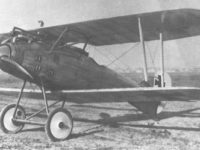After some prototypes of the company Luftfahrzeug-Gesellschaft m.b.H. which were not further built, could only be developed with the Roland D.VI aircraft, which also could not keep up with others, but at least in a small number was built.
Development and construction:
After the Roland D.III under the direction of engineer Tantzen two further prototypes were created, which were not further produced. In November 1917 flew then for the first time the Roland D.VI, which was constructed like with the D.II with the very stable winding hull and equipped with a 160 HP strong Mercedes D III in-line engine.
Since this prototype did not convince the German Army Command, two more aircraft with the designation D.VIa and D.VIb were built, the D.VIb was equipped with a 150 hp Benz Bz III engine.
In the comparison flies in Berlin Adlershof in January and February 1918 both aircraft were also not convincing and were also inferior to the Fokker D.VII also clearly inferior. Nevertheless, there was an order for a small number of pieces, as the Army Command feared that in case of a delivery failure Fokker would not be able to deliver any aircraft.
Use in the First World War:
Despite some innovations and improvements compared to the predecessor models, from July 1918 until the end of the war a maximum of 70 Roland D.VI aircraft were deployed on the Western Front. In total, however, 353 pieces were built, most were only for the training of pilots.
After the war, 13 planes had to be delivered to the US, which tested them extensively. The only surviving copy of the aircraft is in the Polish Aviation Museum in Krakow, which was stolen after the end of World War II by Poland from the German Aviation Collection Berlin.
Technical specifications:v
| Designation: | Roland D.VI |
| Country: | German Empire |
| Typ: | Fighter plane |
| Length: | 6,32 meters |
| Span: | 9,42 meters |
| Height: | 2,6 meters |
| Mass: | 640kg empty |
| Crew: | Max. 1 |
| Engine: | Water-cooled six-cylinder inline engine Mercedes D III 160 hp or Benz Bz.IIIa 150 hp |
| Maximum speed: | 190 or 220 km/h |
| Reach: | 380 to 400 kilometers |
| Armament: | 2 x synchronized machine guns 7,92 mm LMG 08/15 |
You can find the right literature here:
Fokker Dr I Aces of World War 1 (Aircraft of the Aces)
Undoubtedly the most famous fighter type to see service on either side during World War 1, the Fokker Dr I was a revelation when it entered service on the western front in 1917. Manfred von Richthofens JG 1 circus was the first Jasta to completely re-equip with the new fighter, and in the skilled hands of its numerous aces the Dr I proved a formidable opponent. The Dr I remained in service on the Western Front until replaced by the superior Fokker D VII in May 1918. Just weeks prior to that, however, Germanys leading ace, the great Red Baron, had been killed at the controls of a Dr I.
Friedrichshafen Aircraft of WWI: A Centennial Perspective on Great War Airplanes (Great War Aviation) (Volume 21)

Friedrichshafen Aircraft of WWI: A Centennial Perspective on Great War Airplanes (Great War Aviation) (Volume 21) Paperback – February 16, 2016
This book describes and illustrates the development of Friedrichshafen aircraft of WWI with text, 540 photos, 18 in color, 37 color profiles, production quantities and serial numbers of aircraft, and aircraft dimensions and performance specifications. In addition, there are 26 official SVK drawings and 11 aircraft are illustrated in scale drawings to 1/48 (4) or 1/72 (7) scales. The book has 312 pages and is of interest to aviation historians, enthusiasts, and modelers alike.
German and Austro-Hungarian Aircraft Manufacturers 1908-1918
Much has been written about the British aircraft of the First World War, but little has surfaced about the aircraft of the Axis powers, Germany and Austria. Here, Terry C. Treadwell tells the story of the aircraft from companies such as Fokker, builder of the famous triplane, as fl own by Baron von Richthofen's Flying Circus, AEG, Albatros, Junkers and Hansa. From reconnaissance aircraft to state-of-the-art bombers that could reach London, this is the definitive guide to aircraft of the Axis powers during the First World War. The aircraft are explained in detail and a history of each company is provided, making this an excellent source book for aircraft enthusiasts, model makers and those interested in the air war over the trenches of France and Belgium, as well as further afield in the Italian campaign.
The Zeppelin in Combat: A History of the German Naval Airship Division
The standard reference now revised and expanded. Dr. Robinson has opened up his vast photo archives to enhance this new edition of his classic work. Much of the new photographic material is published here for the first time.
This post is also available in:
 Deutsch (German)
Deutsch (German)  Français (French)
Français (French)  Italiano (Italian)
Italiano (Italian)  简体中文 (Chinese (Simplified))
简体中文 (Chinese (Simplified))  Русский (Russian)
Русский (Russian)  Español (Spanish)
Español (Spanish)  العربية (Arabic)
العربية (Arabic)

















